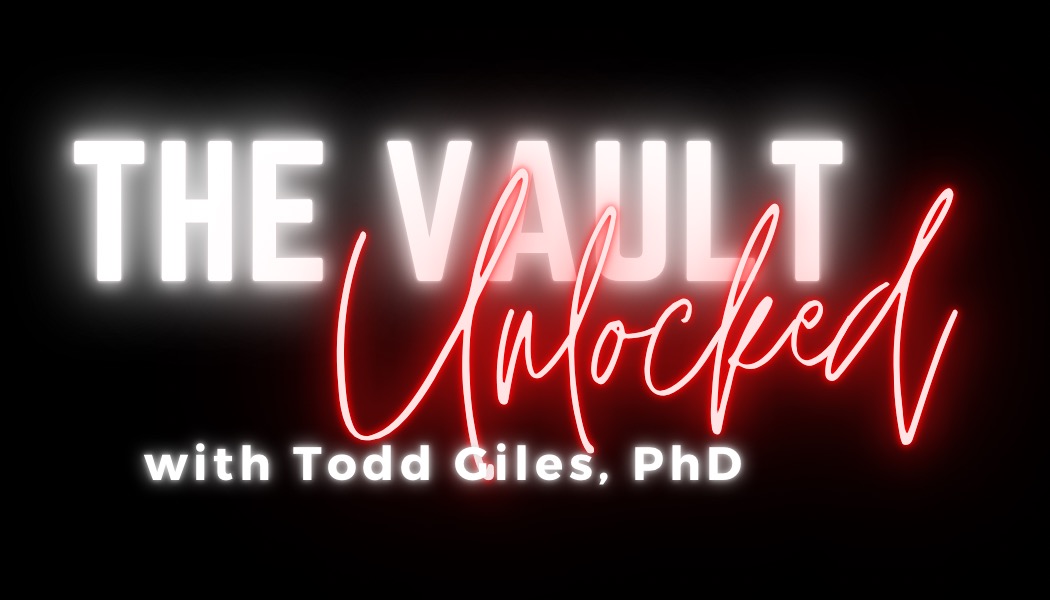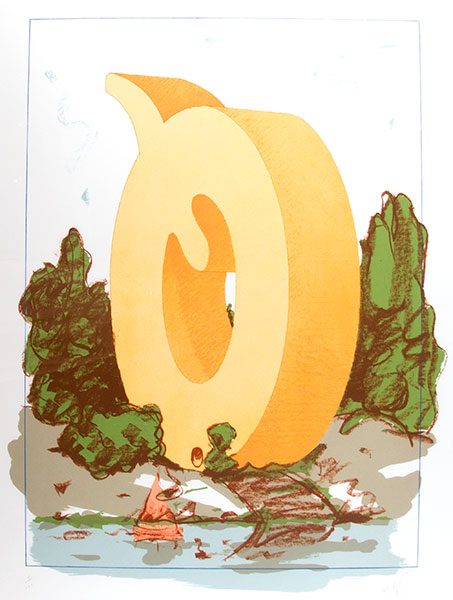
Ever wonder where the art is stored at the WFMA, and what's in there anyway? Join MSU professor Todd Giles as he unlocks the vault!

Claes Oldenburg
The Letter Q as Beach House with Sailboat, 1972
Lithograph
39 x 29 1/2 in
Signed with initials
Numbered 8/100
Gemini G.E.L., Los Angeles
Museum purchase assisted by the National Endowment for the Arts, 1975
“Sitting in a car and watching letters silhouetted against the sky has always seemed to me the basic Los Angeles experience.”
~Claes Oldenburg
[Transcript]
Hello and welcome to The Vault Unlocked. My name is Todd Giles and we’re here to take you inside the collection vault at the Wichita Falls Museum of Art at MSU Texas, because getting to know art helps us better know ourselves. In this episode, we will take a close look at Claes Oldenburg’s 1972 lithograph The Letter Q as Beach House with Sailboat.
Though best known for his oversized whimsical public sculptures of everyday items such as the huge Shuttlecocks adorning the lawn of the Nelson-Atkins Museum of Art in Kansas City or the “soft-sculptures” of hamburgers and cake slices which sit directly on gallery floors, Claes Oldenburg is also a consummate draftsman and printmaker. Like many artists of his day, Oldenburg was initially skeptical about the veracity of printmaking as a fine art form. And, like his immediate Neo-Dadaist predecessors Jasper Johns and Robert Rauschenberg, and Pop Art contemporaries Tom Wesselmann and Robert Indiana (all represented in the WFMA’s permanent collection), Oldenburg quickly warmed to the medium, which he found rich, varied, and artistically challenging. Indeed, once he accepted working collectively with printmakers, he ended up producing prints at most of the major presses in Europe and the US, such as Gemini G.E.L. in Los Angeles, where he completed The Letter Q as Beach House with Sailboat in August of 1972
As is the case with his monumental sculptures, the main figure of The Letter Q dwarfs everything around it, including its presumed viewers. And, as with his sculptures, Oldenburg, in a manner similar to that of his Modernist predecessor Marcel Duchamp, takes the most mundane of objects—an eraser, a screw, a toilet—and by virtue of his creativity, upends traditional relationships between high and low culture, between viewer and object. This is the King Kong of Qs; if it wasn’t so silly, it would be terrifying, like the gigantic disembodied breast that terrorizes the countryside in Woody Allen’s Everything You Always Wanted to Know About Sex* (*But Were Afraid to Ask) of the same year. At the very least, Qing Qong here is certainly disconcerting and mind-boggling.
As described by art historians Richard Axsom and David Platzker, it was at Gemini that Oldenburg began experimenting with lithographic overprintings. The composition of The Letter Q, for example, “entailed fifteen runs of inked aluminum plates in order for color blocks, line, and crayon drawing to emulate the style of [Oldenburg’s] watercolor drawings” (24). In other words, each of the fifteen plates carried a single color of printer’s ink on a unique image, so the subject was built by running the paper through the press fifteen times, one color at a time. It was also with this lithograph that Oldenburg began the practice of framing his images with thin blue lines to formally set off his subjects, even though here he intentionally colors outside of the lines, so to speak. Four years after completing the final edition of 100 prints of The Letter Q, Oldenburg revisited the theme again in Sailboat Thinking of Q, based on a 1973 drawing of the same name.
So, really, what do we even do with a surreal artwork like this? Scratch our heads and walk on to the next piece? Stand mock-adoringly before it, chin in hand, mumbling vague multisyllabic absurdities to mask our own embarrassment and befuddlement? Get angry at the artist? Get angry at the museum? Or laugh out loud at our own absurdity for trying to be so serious just because we’re at an art exhibition? The latter, methinks, is perhaps the most legitimate thing to do in the face of The Letter Q as Beach House with Sailboat. Maybe that’s a copout, though; I don’t know. What I do know is that artwork like this exists for a reason—it exists to push us into contemplating not only our own understanding of art in general, but also to consider the world around us, not to mention the world in which the artwork itself was conceived, created, and originally found an audience.
What do we see when we look at The Letter Q? We could start by looking at the formal elements of the work—line, color, depth, shape, etc. We could talk, for example, about the subtlety of the crisp lines juxtaposed against the rough brown crayon-like scribbles, or the shading and overlapping of colors, but to what ends? Or we could describe the narrative playing out within the thin blue lines—the small sailboat hugging the shoreline on a lovely clear day, the bright green groupings of trees to the left and right, the curvilinear dirt path leading down to the shore, and, lest you missed it upon first viewing, the gigantic yellow and orange inverted capital letter Q towering Godzilla-like over our otherwise idyllic beachside getaway. All I want to do is get away from that inexplicable thing calling itself a beach house, one might think. What nerve from that has been of a letter! And in such a genteel setting! Preposterous!
OK, seriously, what is it that Oldenburg is saying here? Is he making a statement about the gaudiness of the nouveau riche? About contemporary West Coast architecture? About the ways in which we destroy Mother Nature to get the best seat in the house? I don’t rightly know what his message is and, frankly, I don’t think his original intent or inspiration much matters because sometimes the questions are more important than the answers. Sometimes there is no single absolute truth, no right way to see or understand our world; sometimes art and literature and music are best understood through our own unique subjectivity. Oldenburg would agree: “Because my work is naturally non-meaningful, the meaning found in it will remain doubtful and inconsistent—which is the way it should be. . . . All that I care about is that like any startling piece of nature, it should be capable of stimulating meaning.”
And stimulate it does. Oldenburg’s work, whether it’s his monumental outside public art, his “soft sculptures,” or his work on paper, is always witty, goofy, jaw-dropping, disconcerting, and yes, like all art worth its sea salt, critical. It invites and incites us to think critically about it and ourselves, while at the same time critiquing the social and artistic milieu within which it itself was originally created. Do we need to understand The Letter Q as Beach House with Sailboat? No, absolutely not. Do we need to gnaw on it awhile and come back to it again and again? Yes, absolutely.
Thanks for joining us as we unlock the vault at the Wichita Falls Museum of Art at MSU Texas. To learn more about the WFMA, our current and upcoming exhibitions, the permanent collection, as well as sign up for our e-newsletter, visit wfma.msutexas.edu.
Works Consulted
Axsom, Richard H. and David Platzker. Printed Stuff: Prints, Posters, and Ephemera by Claes Oldenburg, A Catalogue Raisonné 1958-1996. Hudson Hills Press, 1998.
Fine, Ruth. Gemini G.E.L.: Art and Collaboration. Washington: National Gallery of Art, 1985.
The Letter Q as Beach House with Sailboat from the Permanent Collection of the Wichita Falls Museum of Art at MSU Texas
View Previous The Vault Unlocked
-
Tuesday - Friday
10:00AM - 5:00PMSaturday
1:00PM - 5:00PM